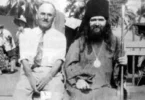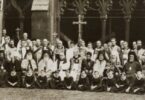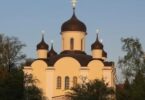The Council of the Russian Church Abroad decided to glorify Holy Righteous Fr. John of Kronstadt on this day in 1964
St. John was venerated as “a priest for all Russia” even during his lifetime, and this veneration continued among many Orthodox who found themselves in the emigration. The first and second volume titled Otets Ioann Kronshtadskii: Zhizn’ i chudesa [Fr. John of Kronstadt: Life and Miracles] by “I. K. Surskii” came out in Belgrade in 1938 and 1941. The author’s real name was Iakov V. Illiashevich (1870–1953). He was President of the Belgrade Fraternity in Memory of Father John of Kronstadt. (His daughter was long time choir member of the ROCOR’s London cathedral.) The first volume contains, besides testimonies to the veneration of St. John in the emigration, an article by Archbishop Theophan of Poltava on the question of canonizing Father John of Kronstadt (in Chapter 68). The second volume contains an akathist to the Honorable and Glorious Priest of God John of Kronstadt in Chapter 76.
Popular veneration frequently precedes glorification, and the hierarchy’s task is therefore to “give ear” to the Church. This may explain the following address by St. John of Shanghai and San Francisco during the time he was the ruling hierarch of the Diocese of Western Europe:
“In view of the forthcoming consideration in September of this year (1953) of the petition to glorify Father John of Kronstadt, I am asking [each of] the clergy to inform me, according to their clerical conscience:
- Is he personally convinced of the holiness of Father John, Archpriest of Kronstadt?
- According to his observations, is this the belief of his flock or his spiritual children?
- If the response to the above questions is positive, does he acknowledge that Fr. John’s urgent glorification is necessary and desirable?”
Appeals from devotees came in anticipation of the immediate glorification of Holy Righteous John of Kronstadt in 1953. Thus, for example, parishioners of St. Nicholas Church in Utica, New York, made the following appeal to all Russians: “We call upon everyone to write to their ruling hierarchs, asking them to inform the Council of Bishops that the time has come to glorify Father John.” Panikhidas were being served for Fr. John and meetings were being held to speak about the podvig of his ministry. Nonetheless, the 1953 Council of Bishops, while not objecting in principle to a possible glorification, ruled to postpone the glorification of Holy Righteous John of Kronstadt, taking note of the position on the issue of the ROCOR Primate, Metropolitan Anastassy (Gribanovsky), who “did not find it possible to bring about this glorification immediately, only because Father John’s canonization requires the participation of our Mother, the Russian Orthodox Church, liberated from captivity.” Thus, the question of glorification also depended upon the status of ROCOR. The Church outside Russia, existing temporarily, had no right to perform an action, which would have exceeded its minimal aim of surviving.
On May 27, 1964, the Council of Bishops elected Metropolitan Philaret (Voznesensky) as the new First Hierarch to replace the aged Metropolitan Anastassy, and by June 3, the same Council unanimously adopted a resolution to glorify Fr. John of Kronstadt. The following justification was given to amend the decision of the 1953 Council:
“A judgment was made regarding the necessity of a popular glorification of Father John of Kronstadt back at the 1953 Council of Bishops. Since then, more than ten years have transpired and not only have conditions not changed in the Russian land, but persecutions of Christ’s Church have intensified there. Therefore, the uttermost moment has come when we ought to appeal to heavenly assistance and to the prayerful intercession of this God-pleaser, who truly was a good shepherd for the Russian people, laying down his soul for his people.”
Moreover, through the creation of such a precedent, the theoretical possibility of the glorification of saints by the Russian Church Abroad was resolved positively. The glorification took place on November 1, 1964, in the Synodal Cathedral of the Mother of God of the Sign in New York, and in the Church of St. John of Ryla (which since that moment has been the Memorial Church of St. John of Kronstadt).










